Financial Feasibility Analysis of Pinto Ltd Project - ACC00716
VerifiedAdded on 2023/06/11
|6
|1141
|267
Report
AI Summary
This report provides a financial analysis of Pinto Ltd's proposed new product launch, addressing concerns about increasing competition. It assesses the project's financial feasibility using capital budgeting tools such as NPV, IRR, payback period, discounted payback period, and profitability index. The analysis considers incremental post-tax cash flows, the opportunity cost of using an existing manufacturing base, and sunk costs. Uncertainty analysis, including scenario and sensitivity analyses, examines the project's robustness under varying discount rates and unit sales growth rates. The report concludes with a recommendation to proceed with the project, highlighting its financial viability and resilience to adverse conditions, while emphasizing the importance of ongoing monitoring and adjustments during implementation.

FINANCE
MEMORANDUM
STUDENT ID:
[Pick the date]
MEMORANDUM
STUDENT ID:
[Pick the date]
Paraphrase This Document
Need a fresh take? Get an instant paraphrase of this document with our AI Paraphraser
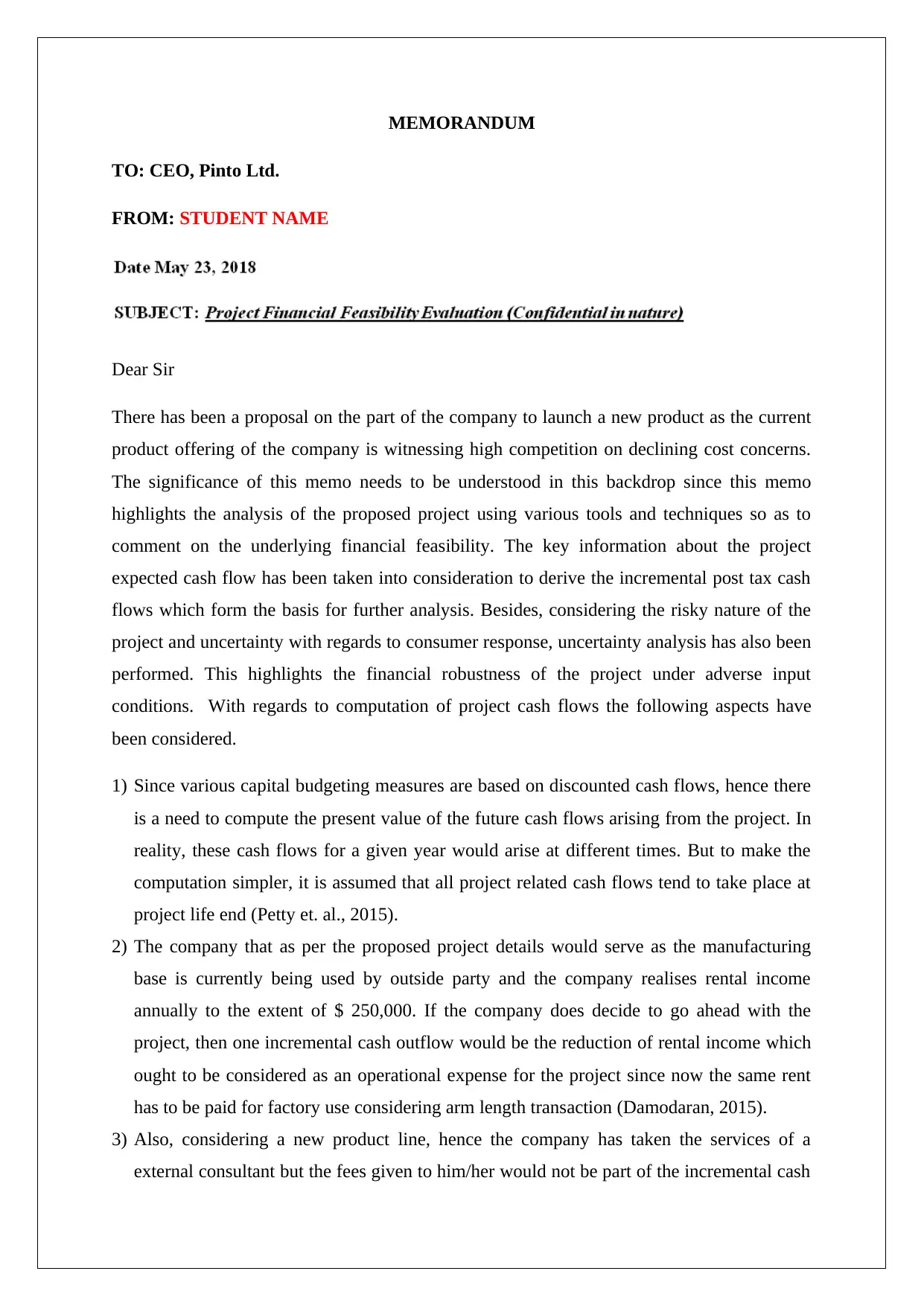
MEMORANDUM
TO: CEO, Pinto Ltd.
FROM: STUDENT NAME
Dear Sir
There has been a proposal on the part of the company to launch a new product as the current
product offering of the company is witnessing high competition on declining cost concerns.
The significance of this memo needs to be understood in this backdrop since this memo
highlights the analysis of the proposed project using various tools and techniques so as to
comment on the underlying financial feasibility. The key information about the project
expected cash flow has been taken into consideration to derive the incremental post tax cash
flows which form the basis for further analysis. Besides, considering the risky nature of the
project and uncertainty with regards to consumer response, uncertainty analysis has also been
performed. This highlights the financial robustness of the project under adverse input
conditions. With regards to computation of project cash flows the following aspects have
been considered.
1) Since various capital budgeting measures are based on discounted cash flows, hence there
is a need to compute the present value of the future cash flows arising from the project. In
reality, these cash flows for a given year would arise at different times. But to make the
computation simpler, it is assumed that all project related cash flows tend to take place at
project life end (Petty et. al., 2015).
2) The company that as per the proposed project details would serve as the manufacturing
base is currently being used by outside party and the company realises rental income
annually to the extent of $ 250,000. If the company does decide to go ahead with the
project, then one incremental cash outflow would be the reduction of rental income which
ought to be considered as an operational expense for the project since now the same rent
has to be paid for factory use considering arm length transaction (Damodaran, 2015).
3) Also, considering a new product line, hence the company has taken the services of a
external consultant but the fees given to him/her would not be part of the incremental cash
TO: CEO, Pinto Ltd.
FROM: STUDENT NAME
Dear Sir
There has been a proposal on the part of the company to launch a new product as the current
product offering of the company is witnessing high competition on declining cost concerns.
The significance of this memo needs to be understood in this backdrop since this memo
highlights the analysis of the proposed project using various tools and techniques so as to
comment on the underlying financial feasibility. The key information about the project
expected cash flow has been taken into consideration to derive the incremental post tax cash
flows which form the basis for further analysis. Besides, considering the risky nature of the
project and uncertainty with regards to consumer response, uncertainty analysis has also been
performed. This highlights the financial robustness of the project under adverse input
conditions. With regards to computation of project cash flows the following aspects have
been considered.
1) Since various capital budgeting measures are based on discounted cash flows, hence there
is a need to compute the present value of the future cash flows arising from the project. In
reality, these cash flows for a given year would arise at different times. But to make the
computation simpler, it is assumed that all project related cash flows tend to take place at
project life end (Petty et. al., 2015).
2) The company that as per the proposed project details would serve as the manufacturing
base is currently being used by outside party and the company realises rental income
annually to the extent of $ 250,000. If the company does decide to go ahead with the
project, then one incremental cash outflow would be the reduction of rental income which
ought to be considered as an operational expense for the project since now the same rent
has to be paid for factory use considering arm length transaction (Damodaran, 2015).
3) Also, considering a new product line, hence the company has taken the services of a
external consultant but the fees given to him/her would not be part of the incremental cash
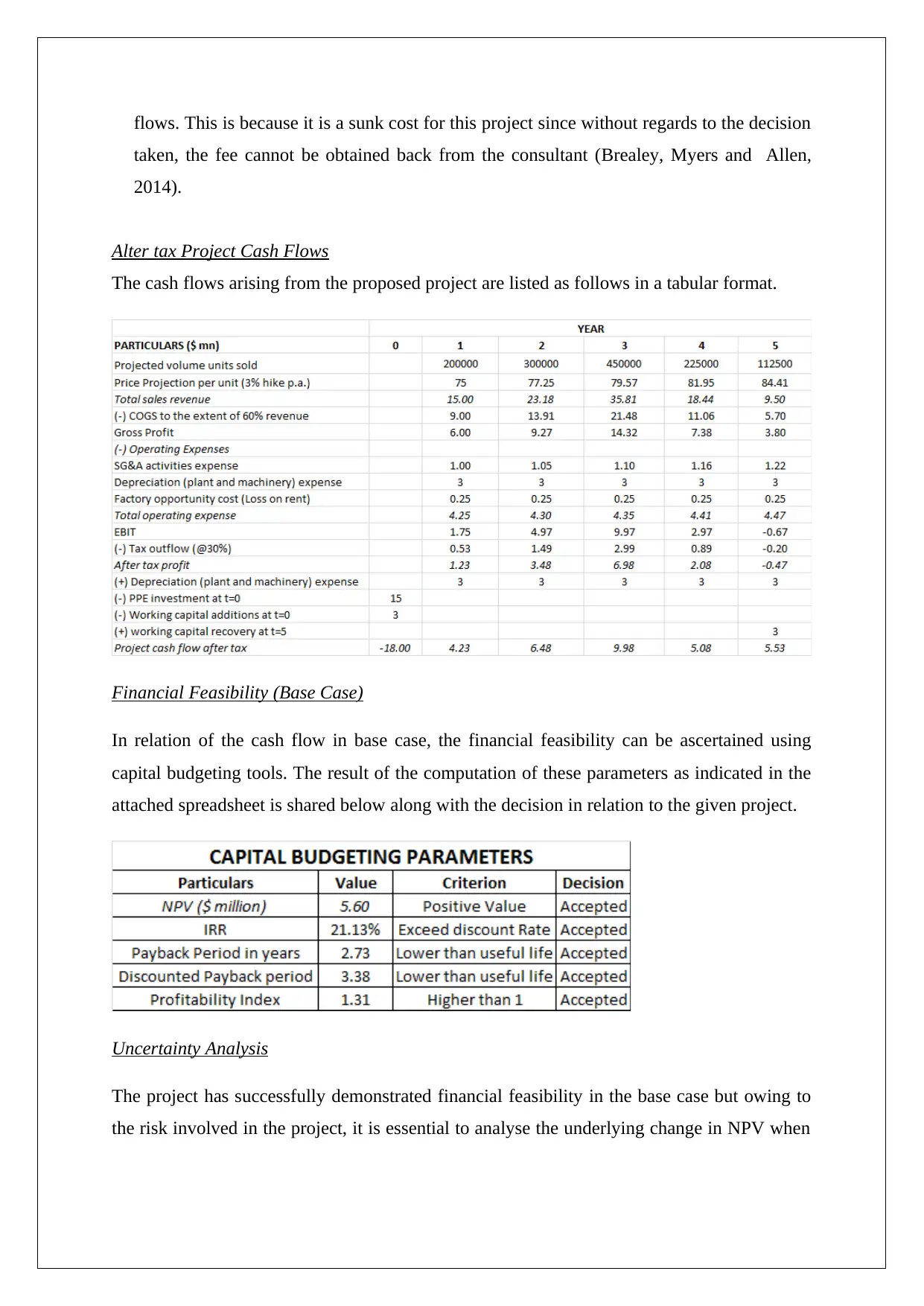
flows. This is because it is a sunk cost for this project since without regards to the decision
taken, the fee cannot be obtained back from the consultant (Brealey, Myers and Allen,
2014).
Alter tax Project Cash Flows
The cash flows arising from the proposed project are listed as follows in a tabular format.
Financial Feasibility (Base Case)
In relation of the cash flow in base case, the financial feasibility can be ascertained using
capital budgeting tools. The result of the computation of these parameters as indicated in the
attached spreadsheet is shared below along with the decision in relation to the given project.
Uncertainty Analysis
The project has successfully demonstrated financial feasibility in the base case but owing to
the risk involved in the project, it is essential to analyse the underlying change in NPV when
taken, the fee cannot be obtained back from the consultant (Brealey, Myers and Allen,
2014).
Alter tax Project Cash Flows
The cash flows arising from the proposed project are listed as follows in a tabular format.
Financial Feasibility (Base Case)
In relation of the cash flow in base case, the financial feasibility can be ascertained using
capital budgeting tools. The result of the computation of these parameters as indicated in the
attached spreadsheet is shared below along with the decision in relation to the given project.
Uncertainty Analysis
The project has successfully demonstrated financial feasibility in the base case but owing to
the risk involved in the project, it is essential to analyse the underlying change in NPV when
⊘ This is a preview!⊘
Do you want full access?
Subscribe today to unlock all pages.

Trusted by 1+ million students worldwide
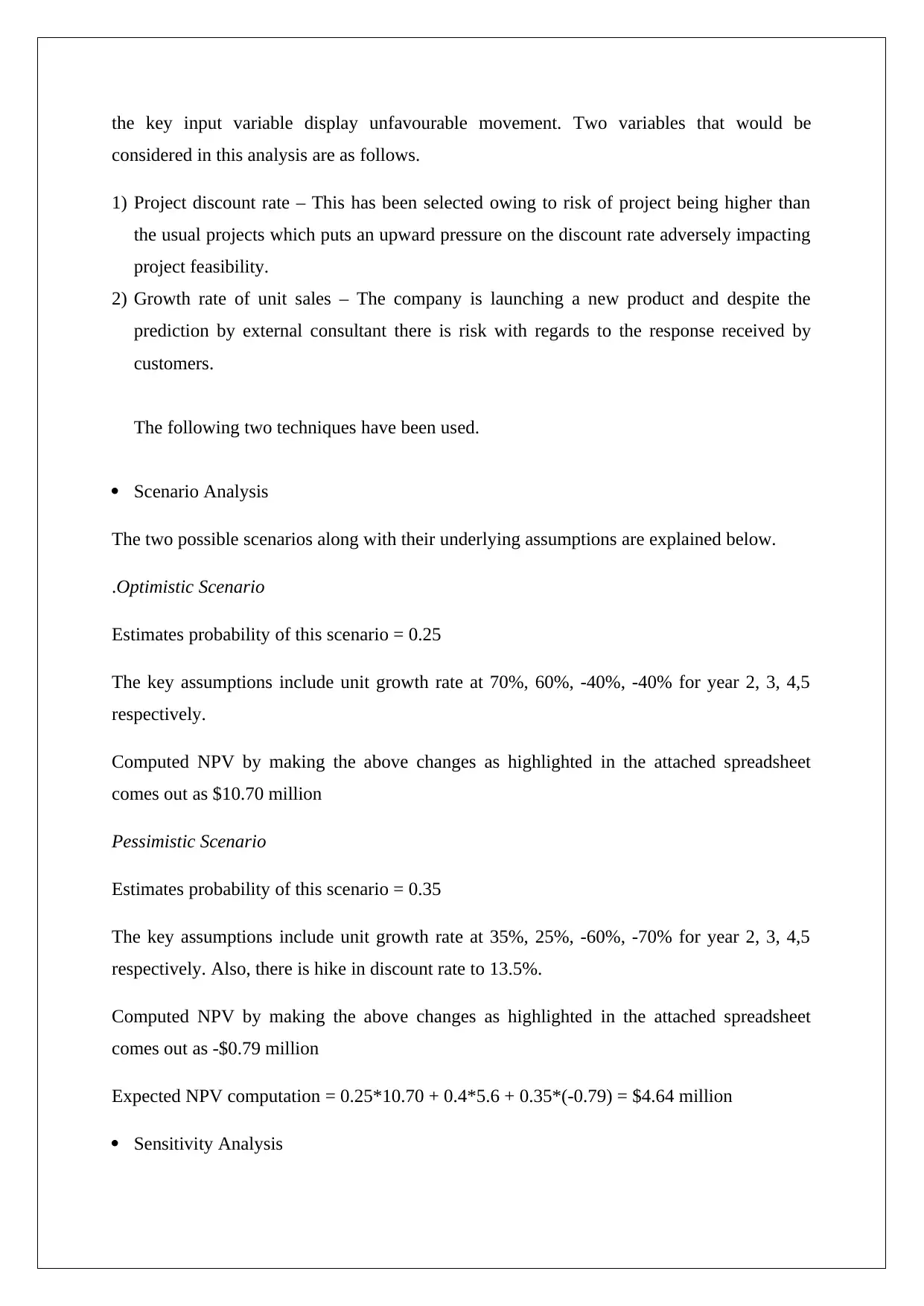
the key input variable display unfavourable movement. Two variables that would be
considered in this analysis are as follows.
1) Project discount rate – This has been selected owing to risk of project being higher than
the usual projects which puts an upward pressure on the discount rate adversely impacting
project feasibility.
2) Growth rate of unit sales – The company is launching a new product and despite the
prediction by external consultant there is risk with regards to the response received by
customers.
The following two techniques have been used.
Scenario Analysis
The two possible scenarios along with their underlying assumptions are explained below.
.Optimistic Scenario
Estimates probability of this scenario = 0.25
The key assumptions include unit growth rate at 70%, 60%, -40%, -40% for year 2, 3, 4,5
respectively.
Computed NPV by making the above changes as highlighted in the attached spreadsheet
comes out as $10.70 million
Pessimistic Scenario
Estimates probability of this scenario = 0.35
The key assumptions include unit growth rate at 35%, 25%, -60%, -70% for year 2, 3, 4,5
respectively. Also, there is hike in discount rate to 13.5%.
Computed NPV by making the above changes as highlighted in the attached spreadsheet
comes out as -$0.79 million
Expected NPV computation = 0.25*10.70 + 0.4*5.6 + 0.35*(-0.79) = $4.64 million
Sensitivity Analysis
considered in this analysis are as follows.
1) Project discount rate – This has been selected owing to risk of project being higher than
the usual projects which puts an upward pressure on the discount rate adversely impacting
project feasibility.
2) Growth rate of unit sales – The company is launching a new product and despite the
prediction by external consultant there is risk with regards to the response received by
customers.
The following two techniques have been used.
Scenario Analysis
The two possible scenarios along with their underlying assumptions are explained below.
.Optimistic Scenario
Estimates probability of this scenario = 0.25
The key assumptions include unit growth rate at 70%, 60%, -40%, -40% for year 2, 3, 4,5
respectively.
Computed NPV by making the above changes as highlighted in the attached spreadsheet
comes out as $10.70 million
Pessimistic Scenario
Estimates probability of this scenario = 0.35
The key assumptions include unit growth rate at 35%, 25%, -60%, -70% for year 2, 3, 4,5
respectively. Also, there is hike in discount rate to 13.5%.
Computed NPV by making the above changes as highlighted in the attached spreadsheet
comes out as -$0.79 million
Expected NPV computation = 0.25*10.70 + 0.4*5.6 + 0.35*(-0.79) = $4.64 million
Sensitivity Analysis
Paraphrase This Document
Need a fresh take? Get an instant paraphrase of this document with our AI Paraphraser
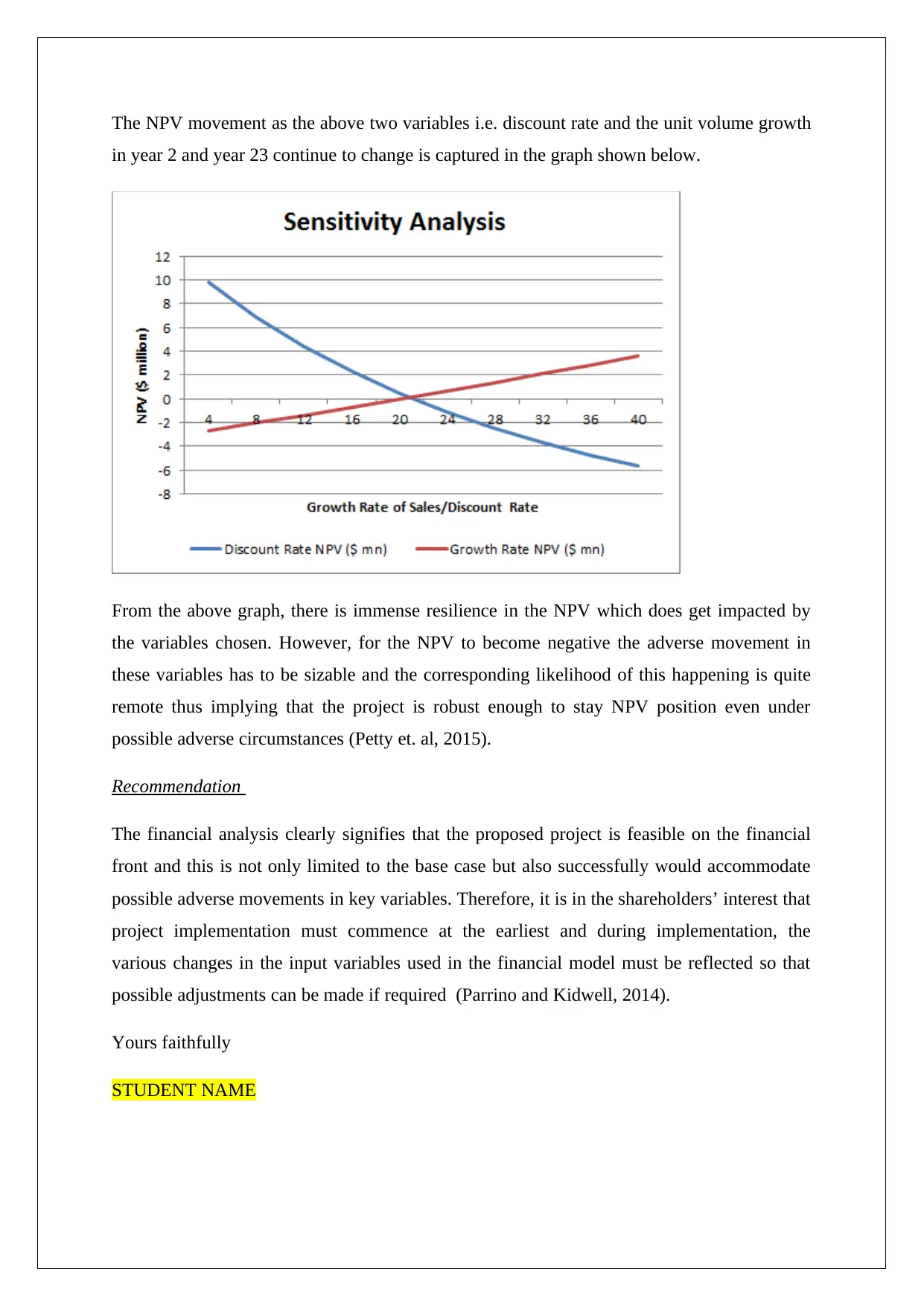
The NPV movement as the above two variables i.e. discount rate and the unit volume growth
in year 2 and year 23 continue to change is captured in the graph shown below.
From the above graph, there is immense resilience in the NPV which does get impacted by
the variables chosen. However, for the NPV to become negative the adverse movement in
these variables has to be sizable and the corresponding likelihood of this happening is quite
remote thus implying that the project is robust enough to stay NPV position even under
possible adverse circumstances (Petty et. al, 2015).
Recommendation
The financial analysis clearly signifies that the proposed project is feasible on the financial
front and this is not only limited to the base case but also successfully would accommodate
possible adverse movements in key variables. Therefore, it is in the shareholders’ interest that
project implementation must commence at the earliest and during implementation, the
various changes in the input variables used in the financial model must be reflected so that
possible adjustments can be made if required (Parrino and Kidwell, 2014).
Yours faithfully
STUDENT NAME
in year 2 and year 23 continue to change is captured in the graph shown below.
From the above graph, there is immense resilience in the NPV which does get impacted by
the variables chosen. However, for the NPV to become negative the adverse movement in
these variables has to be sizable and the corresponding likelihood of this happening is quite
remote thus implying that the project is robust enough to stay NPV position even under
possible adverse circumstances (Petty et. al, 2015).
Recommendation
The financial analysis clearly signifies that the proposed project is feasible on the financial
front and this is not only limited to the base case but also successfully would accommodate
possible adverse movements in key variables. Therefore, it is in the shareholders’ interest that
project implementation must commence at the earliest and during implementation, the
various changes in the input variables used in the financial model must be reflected so that
possible adjustments can be made if required (Parrino and Kidwell, 2014).
Yours faithfully
STUDENT NAME
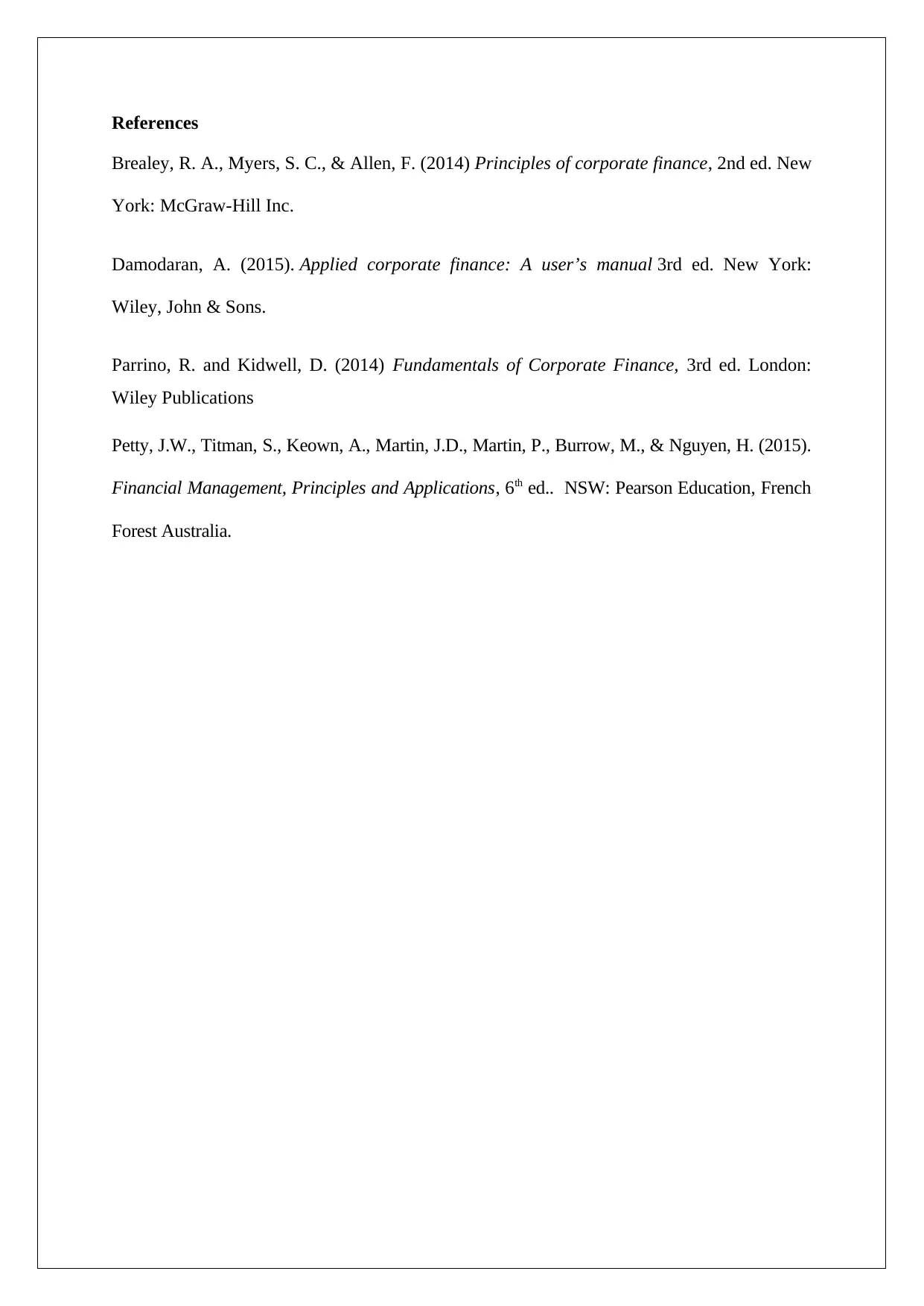
References
Brealey, R. A., Myers, S. C., & Allen, F. (2014) Principles of corporate finance, 2nd ed. New
York: McGraw-Hill Inc.
Damodaran, A. (2015). Applied corporate finance: A user’s manual 3rd ed. New York:
Wiley, John & Sons.
Parrino, R. and Kidwell, D. (2014) Fundamentals of Corporate Finance, 3rd ed. London:
Wiley Publications
Petty, J.W., Titman, S., Keown, A., Martin, J.D., Martin, P., Burrow, M., & Nguyen, H. (2015).
Financial Management, Principles and Applications, 6th ed.. NSW: Pearson Education, French
Forest Australia.
Brealey, R. A., Myers, S. C., & Allen, F. (2014) Principles of corporate finance, 2nd ed. New
York: McGraw-Hill Inc.
Damodaran, A. (2015). Applied corporate finance: A user’s manual 3rd ed. New York:
Wiley, John & Sons.
Parrino, R. and Kidwell, D. (2014) Fundamentals of Corporate Finance, 3rd ed. London:
Wiley Publications
Petty, J.W., Titman, S., Keown, A., Martin, J.D., Martin, P., Burrow, M., & Nguyen, H. (2015).
Financial Management, Principles and Applications, 6th ed.. NSW: Pearson Education, French
Forest Australia.
⊘ This is a preview!⊘
Do you want full access?
Subscribe today to unlock all pages.

Trusted by 1+ million students worldwide
1 out of 6
Related Documents
Your All-in-One AI-Powered Toolkit for Academic Success.
+13062052269
info@desklib.com
Available 24*7 on WhatsApp / Email
![[object Object]](/_next/static/media/star-bottom.7253800d.svg)
Unlock your academic potential
Copyright © 2020–2025 A2Z Services. All Rights Reserved. Developed and managed by ZUCOL.





